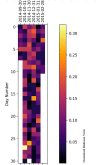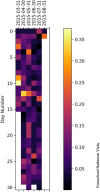IoT in medical diagnosis: detecting excretory functional disorders for Older adults via bathroom activity change using unobtrusive IoT technology
- PMID: 37841702
- PMCID: PMC10574436
- DOI: 10.3389/fpubh.2023.1161943
IoT in medical diagnosis: detecting excretory functional disorders for Older adults via bathroom activity change using unobtrusive IoT technology
Abstract
The Internet of Things (IoT) and Artificial Intelligence (AI) are promising technologies that can help make the health system more efficient, which concurrently can be particularly useful to help maintain a high quality of life for older adults, especially in light of healthcare staff shortage. Many health issues are challenging to manage both by healthcare staff and policymakers. They have a negative impact on older adults and their families and are an economic burden to societies around the world. This situation is particularly critical for older adults, a population highly vulnerable to diseases that needs more consideration and care. It is, therefore, crucial to improve diagnostic and management as well as proposed prevention strategies to enhance the health and quality of life of older adults. In this study, we focus on detecting symptoms in early stages of diseases to prevent the deterioration of older adults' health and avoid complications. We focus on digestive and urinary system disorders [mainly the Urinary Tract Infection (UTI) and the Irritable Bowel Syndrome (IBS)] that are known to affect older adult populations and that are detrimental to their health and quality of life. Our proposed approach relies on unobtrusive IoT and change point detections algorithms to help follow older adults' health status daily. The approach monitors long-term behavior changes and detects possible changes in older adults' behavior suggesting early onsets or symptoms of IBS and UTI. We validated our approach with medical staff reports and IoT data collected in the residence of 16 different older adults during periods ranging from several months to a few years. Results are showing that our proposed approach can detect changes associated to symptoms of UTI and IBS, which were confirmed with observations and testimonies from the medical staff.
Keywords: Internet of Things; early detection; excretory functional disorders; irritable bowel syndrome; older adults; urinary tract infection.
Copyright © 2023 Abdulrazak, Mostafa Ahmed, Aloulou, Mokhtari and Blanchet.
Conflict of interest statement
The authors declare that the research was conducted in the absence of any commercial or financial relationships that could be construed as a potential conflict of interest.
Figures















Similar articles
-
Developing Independent Living Support for Older Adults Using Internet of Things and AI-Based Systems: Co-Design Study.JMIR Aging. 2024 Oct 24;7:e54210. doi: 10.2196/54210. JMIR Aging. 2024. PMID: 39447196 Free PMC article.
-
Evaluation of health factors on artificial intelligence and the internet of things-based older adults healthcare programmes.Digit Health. 2024 Jun 14;10:20552076241258663. doi: 10.1177/20552076241258663. eCollection 2024 Jan-Dec. Digit Health. 2024. PMID: 38882246 Free PMC article. Review.
-
Discrepancies in Demand of Internet of Things Services Among Older People and People With Disabilities, Their Caregivers, and Health Care Providers: Face-to-Face Survey Study.J Med Internet Res. 2020 Apr 15;22(4):e16614. doi: 10.2196/16614. J Med Internet Res. 2020. PMID: 32293575 Free PMC article.
-
Current Status and Future Perspectives on the Internet of Things in Oncology.Hematol Oncol Stem Cell Ther. 2023 Jan 17;16(2):102-109. doi: 10.1016/j.hemonc.2021.09.003. Hematol Oncol Stem Cell Ther. 2023. PMID: 34687614 Review.
-
Perceptions of registered nurses on facilitators and barriers of implementing the AI-IoT-based healthcare pilot project for older adults during the COVID-19 pandemic in South Korea.Front Public Health. 2023 Oct 10;11:1234626. doi: 10.3389/fpubh.2023.1234626. eCollection 2023. Front Public Health. 2023. PMID: 37886046 Free PMC article.
Cited by
-
The digital transformation of nursing practice: an analysis of advanced IoT technologies and smart nursing systems.Front Med (Lausanne). 2024 Nov 29;11:1471527. doi: 10.3389/fmed.2024.1471527. eCollection 2024. Front Med (Lausanne). 2024. PMID: 39678028 Free PMC article. Review.
-
Diagnostic accuracy and quality of artificial intelligence models in irritable bowel syndrome: A systematic review.World J Gastroenterol. 2025 Jun 21;31(23):106836. doi: 10.3748/wjg.v31.i23.106836. World J Gastroenterol. 2025. PMID: 40575334 Free PMC article.
References
-
- Loonsk JW. BioSense–a national initiative for early detection and quantification of public health emergencies. MMWR. (2004) 53:53–55. - PubMed
-
- Wheatley GM. The early detection and prevention of disease. Am J Public Health Nations Health. (1957) 164:616. 10.2105/AJPH.47.10.1315-b - DOI
-
- Nozaki M, Kashiwase K, Saito I. Health spending in Japan: Macro-fiscal implications and reform options, J Econ Ageing. (2017) 9:2. 10.1016/j.jeoa.2016.11.002 - DOI
-
- Wilson DH, Consolvo S, Fishkin K, Philipose M. In-home assessment of the activities of daily living of the elderly. In: Conference on Human Factors in Computing Systems. (2005) p. 1–3.
MeSH terms
LinkOut - more resources
Full Text Sources

